Samsung Galaxy A7 (2018) Review
Samsung Galaxy A7 (2018) Review
Samsung Galaxy A7 is a solid mid-ranger
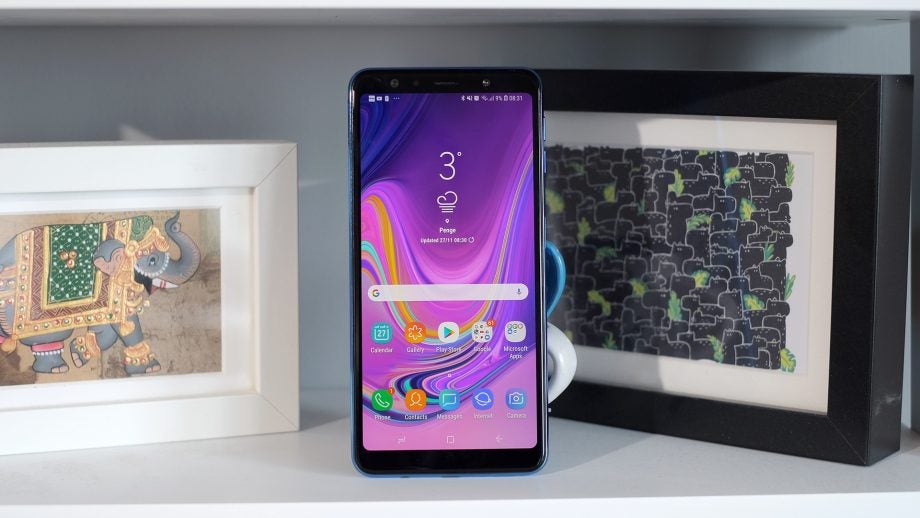
Verdict
A pleasant mid-range Android, if not the very best choice for enthusiasts on a budget.
Pros
- High contrast OLED screen
- Ultra-wide camera is fun to shoot with
- Solid value
Cons
- Weak GPU
- Slow charging
- Slightly soft main camera
Key Specifications
- Review Price: £309
- 64GB storage
- 6-inch 2200 x 1080 pixel Super AMOLED
- Exynos 7885 Octa CPU
- Android 8.0
- 24/8/5MP rear cameras
- 24MP front camera
- 3300mAh battery
What is the Samsung Galaxy A7?
The Samsung Galaxy A7 is a lower-cost alternative to the Samsung Galaxy S10 and Samsung Galaxy Note 9. If you buy by budget rather than brand, this is a really competitor to the Honor 10 or Moto G6 Plus, though.
It’s a mostly compelling choice with some neat extras including an extra ultra-wide camera and a strong OLED screen.
Gamers should pause, though. The Galaxy A7 has a solid CPU, but its graphics chipset is among the weakest in this class.
The Honor 8X, Honor Play and Motorola Moto G6 Plus are all strong alternatives, and cost less. Make peace with the Galaxy A7’s little issues and it’s a good buy, though.
- Read our Samsung Galaxy S10 review

Samsung Galaxy A7 — Design
The Samsung Galaxy A7 is further proof you don’t need to spend big money to get a phone that feels expensive. It’s glass on the front and back, aluminium on the sides. Even the buttons are metal. They are all painted with a plastic-like finish, but there’s otherwise no plastic on show.
It comes in the rich blue colour seen here, black or gold.
That the Samsung Galaxy A7 is almost has chunky as the Note 9 is one of the most important points to consider. Look at the stats and it seems it should be a similar size to the Honor 10, Nokia 7.1 or Moto One.
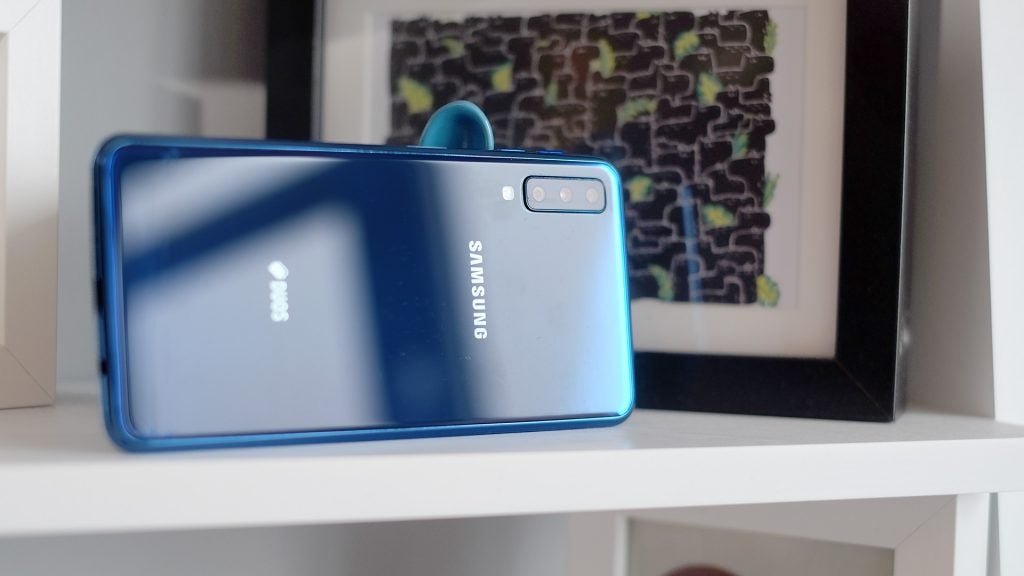
However, as the Samsung Galaxy A7 does not have a notched screen, both the phone size and the perceptual screen size when you watch video are closer to a 6.4-6.5-inch notch model. This is a fairly big phone. That’s no negative point, just make sure you want an enthusiast style model.
There’s a lot to like here, too. The Samsung Galaxy A7 has a 3.5mm headphone jack. And while you won’t see an obvious fingerprint scanner, there is one.
Just like the older Sony Xperia phones, it lives in the power button on the side rather than on the back. And unlike some Sony models, you don’t even need to press down on the actual button too wake it up, it just works on light contact.

You get a very solid 64GB storage too. In the past Samsung’s lower-cost phones have missed out on some features of similarly-priced rivals phones. Not so this time. However, it does not offer the IP-certified water resistance of last year’s A7. When even the OnePlus 6T leaves out water resistance, it seems silly to complain too loudly.
Related: Best mid-range smartphones
Samsung Galaxy A7 — Screen
The Samsung Galaxy A7 has, on one level, the most advanced screen available at the price. It’s a 2280 x 1080 pixel 6-inch screen. The Super AMOLED panel is the special part. Samsung is one of the few companies that can “afford” to fit such a screen into these phones, because these are Samsung panels.
At this resolution and size there are pros and cons to using OLED. The colour coverage is wider than a mid-range LCD screen, and as ever Samsung capitalises on this with some great colour modes. There are four, based on different recognised colour gamuts, just like a Note 9.

Colour fidelity may not be at Note 9 level, but for the price it is great. OLED screens also have unbeatable contrast, thanks to their light-up pixels.
The Galaxy A7 offers the best colour and contrast you can get at this level, but not quite the best sharpness. Thanks to the PenTile sub-pixel arrangement of Samsung OLED screens, the phone looks slightly less sharp than a 1080p phone with an LCD panel.
However, the effect is minor. You’ll just see a tiny bit of fuzz around characters when you look very close, and the Galaxy A7 is still distinctly sharper than, for example, the Moto One. Alongside the Honor 8X this phone has one of the best displays in this class. And for late-night movies, the A7 is easily the better of the two.

OLED tech makes it much easier to apply the Galaxy A7’s always-on screen feature, again thanks to those light-up pixels. Only the lit parts of the screen use significant power, where a standard LCD is either lit-up, or not. The always-on screen shows the time, battery level and notification icons. You can turn this feature off if you find it distracting.
Samsung Galaxy A7 — Software
The Samsung Galaxy A7 runs Android 8.0, and there’s a custom interface on top. It’s not the latest version of Android and nowadays Samsung’s interface is one of the most visually distinctive of all the UIs.
Check out those soft keys: they’re Samsung hieroglyphs, nothing like what you see in standard Android. The Galaxy A7 is also packed with a lot of extra apps.
This sounds like the makings of a reason to avoid the Galaxy A7. It’s not, though, just a reason some of you may want to consider an Android One alternative.
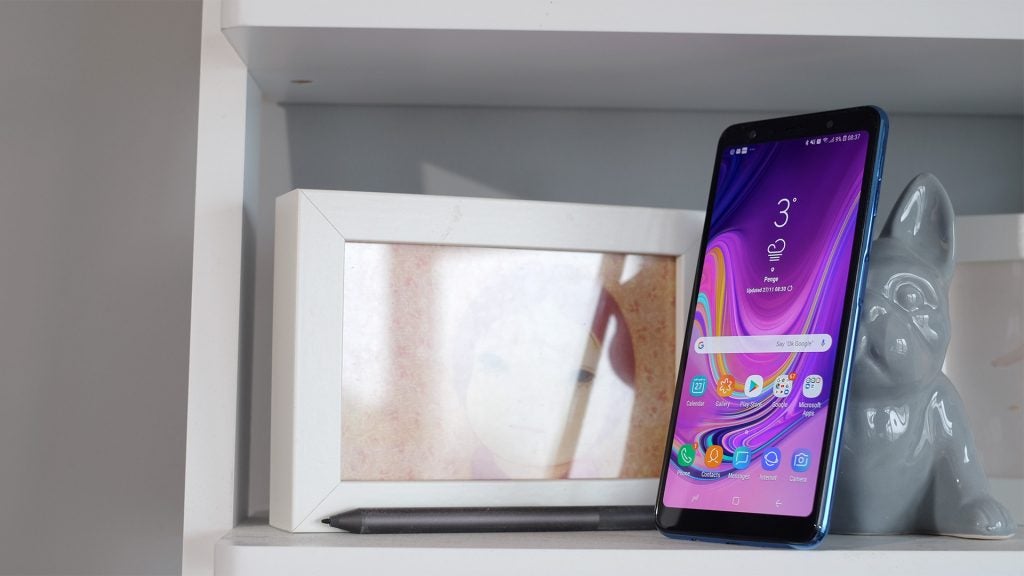
The Galaxy A7’s software is essentially the same as that used by the Galaxy S9 and Note 9. And many of the preinstalled apps are fairly good. Samsung Health? Not bad. Voice recorder? Handy. And preinstalling the Microsoft Office suite seems inoffensive enough.
It only annoys when it tries to take over things Google does well, such as auto-filling of forms and passwords. Samsung tries harder than any Android maker to get under your skin.
The software works perfectly well, though. General performance is among the best at the price, with minimal lag, and no sense your apps get closed down in the background too “early”.
Every phone continues to keep recently-used apps “open” in a frozen saved state. It’s what enables standard phone multi-tasking. But if RAM is limited, these have to be jettisoned fairly quickly. The Galaxy A7 has 4GB RAM, so can afford to keep a good number of parked apps active.
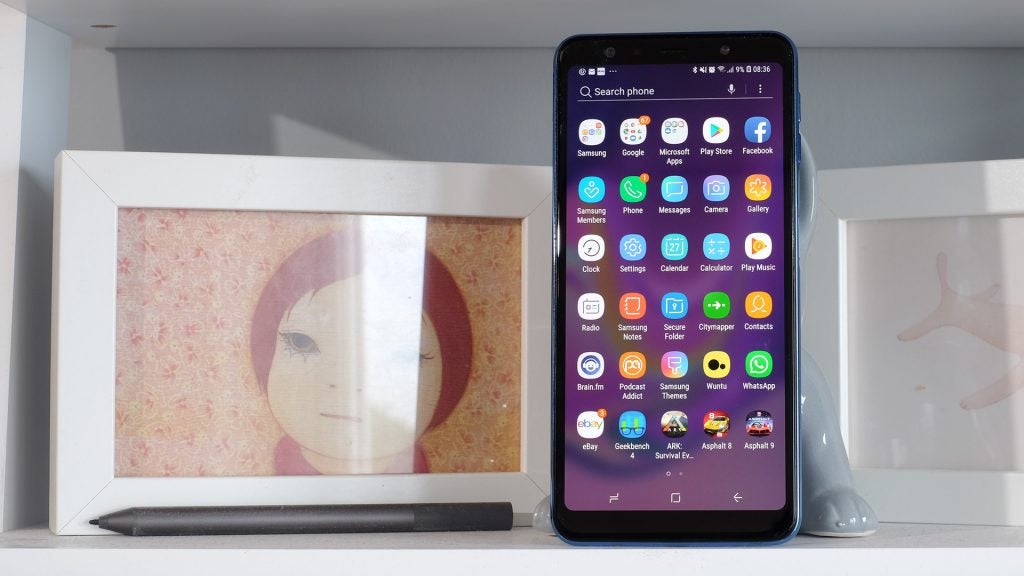
Samsung Galaxy A7 — Performance
The Samsung Galaxy A7 has a Exynos 7885 Octa processor. Its CPU side is actually more impressive than most in this category. Standard procedure is to use eight Cortex-A53 cores, or eight of the newer equivalent Kryo 260 cores.
This processor has six Cortex-A53s and two Cortex-A73s, which used to be the preserve of high-end and upper-mid range phones. It’s may be a lower-end engine, but it is a turbo-charged one.
However, this extra CPU power is unfortunately not matched on the GPU side. The Exynos 7885 Octa has a dual-core Mali G71 GPU: the Mali G71 part is fine, the “dual-core” part less so. Two cores is barely enough to get by at 1080p.

The quad-core Mali G51 of the Honor 8X and Adreno 509 of the Nokia 7.1 are roughly twice as powerful. Even the ageing Adreno 506 of the Snapdragon 625 system on chip used in the Moto One is roughly 20 per cent more powerful.
If there’s a weak point to the Galaxy A7, it’s this graphics chipset. And that it’s paired with a rather good CPU side is all the more annoying.
But how does this pan out in real-world use? It depends entirely on how much of a gamer you are. Most popular games are made with less powerful phones than the Galaxy A7 in mind. However, a game that gives you more control over graphics settings highlights its limitations.
Ark: Survival Evolved only runs at “low” graphics, and only does so well if you significantly reduce the smart resolution slider, which renders part of the scene at lower fidelity.
This kind of compromise traditionally applied to every phone at this level. Mid-range chipsets of the last few years tended to perform well in raw CPU benchmarks, but always had much less powerful graphics chipsets than their top-end relatives. Honor changed that this year with the frankly alarming Honor Play.
It has a twelve-core Mali G72, to the A7’s older dual-core Mali G71. This is a huge disparity. And while the Honor Play has been delisted from 3DMark for cheating, the difference in benchmark scores is not solely down to that. The Honor Play scores around 3000 points in Slingshot Extreme. The Galaxy A7 manages just 740.
In every other respect the Galaxy A7 has what a great gaming phone needs. The screen and storage are there, but its raw graphics power is the weakest around. Hardcore gamers should think twice.
Samsung Galaxy A7 — Camera
There’s some of the same effect in the camera: class-leading specs on paper, but the results are not quite on the same level. The Galaxy A7 has three cameras on the back. There’s a 24-megapixel main sensor, an 8-megapixel wide and a third sensor for depth, to enable Samsung’s “live focus” background blur images.

If we forget image quality for a moment, this is an excellent setup for compositional flexibility. You can take extra-wide shots, DSLR-style shallow depth of field images, and while there’s no “optical” zoom, digital zoom is there as a handy, if deeply unreliable, friend.
On the surface daylight photos are also very pleasant. Samsung’s processing gives images a warm, colour-rich look, with noticeable raising of mid-tones to improve dynamic range. Check out the pics below. Pretty nice, right?
However, compare photos with the Nokia 7.1’s 12-megapixel images and the benefit of the 24 megapixel count here is clearly next to nil. The main camera takes surprisingly soft photos. There’s more detail than in the 8-megapixel wides, but fine detail is still markedly worse than that of the Honor 8X or Nokia 7.1.
That the sharpness of the 8 and 24 megapixel images is comparable, even though the main camera has a much better f/1.7 lens, is damning.
Night photos are only passable too.

 A wide camera gives you a more dramtic view than a zoom
A wide camera gives you a more dramtic view than a zoom

 Some images may look soft close up, but the processing makes for pretty photos
Some images may look soft close up, but the processing makes for pretty photos



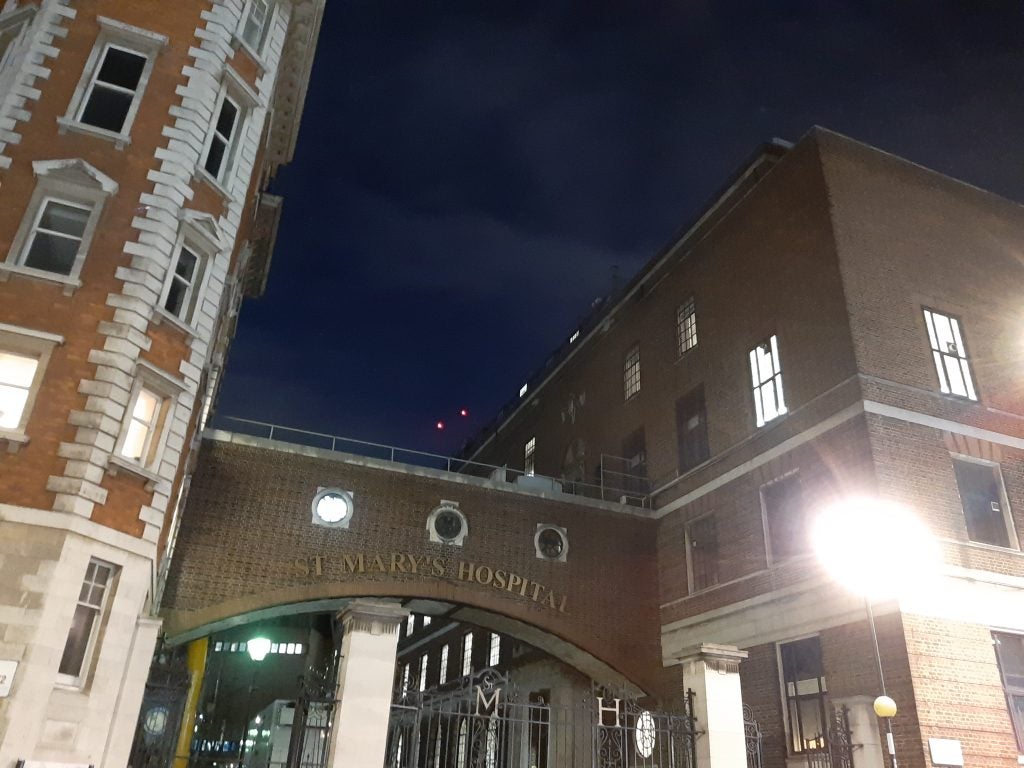
Night shots are only passable

The Galaxy A7’s main camera is lower-end than it seems on paper, and it’s likely because of the sensor’s properties. A Sony IMX576 sensor chip is used in the rear camera.
It has 0.9 micron sensor pixels. 1 micron sensor pixels are small. These are tiny.
The front camera uses a 24-megapixel IMX576 too. In this context it actually seems quite good. Huawei’s superb Mate 20 Pro uses the same selfie sensor.
Strangely, Samsung lists the Exynos 7885 Octa processor’s maximum camera resolution as 21.7 megapixels. Could this be to blame for what is, in some contexts, surprising image softness?
Who knows. Video capture is capped at 1080p too, which may surprise when the resolution is so high. This is not a camera disaster zone. You can take fairly good images with the Galaxy A7, particularly as the underlying colour and dynamic range processing is solid. However, it’s not the best camera at the price, just the most compositionally versatile.
Samsung Galaxy A7 — Battery life
The Samsung Galaxy A7 has a 3300mAh battery. It’s fractionally larger than the Moto G6 Plus’s, and that phone’s screen is also fractionally (0.1in) smaller.
Its stamina is in-line with this sensible but ordinary spec. The Galaxy A7 tends to last a full day of solid use with around 15-20 per cent left by the end.
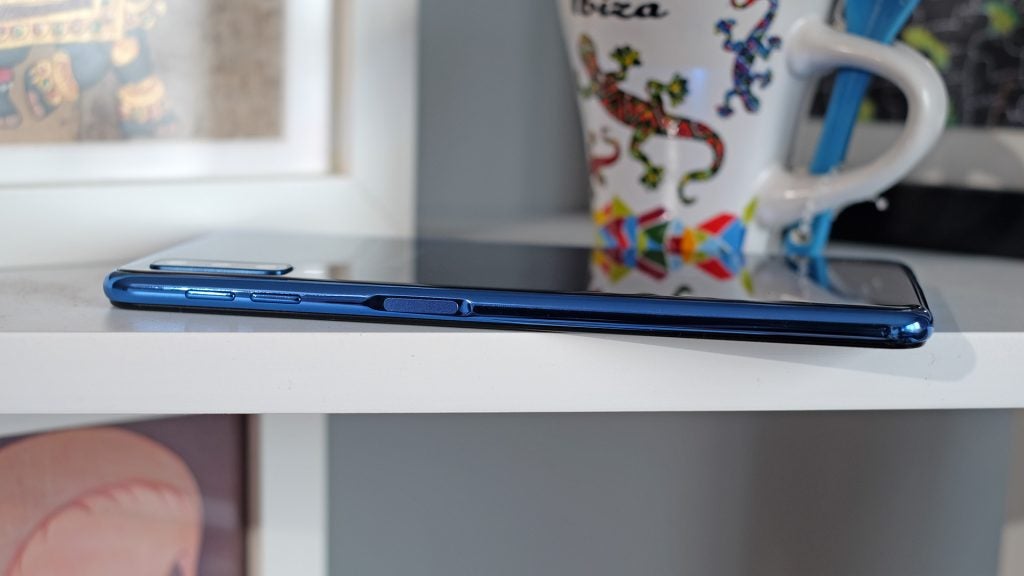
Samsung’s OLED screens are also power-efficient, so you won’t see very fast drain while playing downloaded video unless you set the brightness fairly high.
A few modern touches are missing, though. The Galaxy A7 uses a microUSB port rather than the preferred USB-C. Using the older standard in a budget phono like the Moto E5 seems acceptable, but doing so in a much more expensive phone like this is odd.
There is, predictably, no wireless charging. And, another disappointment, you don’t get a fast charger in the box. Charging takes around 2.5 hours.

Why buy the Samsung Galaxy A7?
The Samsung Galaxy A7 is a phone of conspicuous techy parts and some half-hidden disappointments.
A large, notch-free OLED screen is great for games and video, particularly late-night Netflix that shows off the great contrast. It doesn’t stinge on storage, the wide angle camera is fun to play with and the CPU has a couple of faster cores than the competition.
However, the main camera’s images do not hold up as well as hoped under close scrutiny and the GPU is disappointing. Samsung is doubly to blame here. Not only did it choose the SoC processor, it made the bloody thing.
If you find this phone at the right price, or on the right network, just make sure you keep your gamer expectations in check. It’s otherwise a very pleasant mobile
Verdict
A pleasant mid-range Android, if not the very best choice for enthusiasts on a budget
How we test phones
We test every mobile phone we review thoroughly. We use industry standard tests to compare features properly and we use the phone as our main device over the review period. We’ll always tell you what we find and we never, ever, accept money to review a product.


